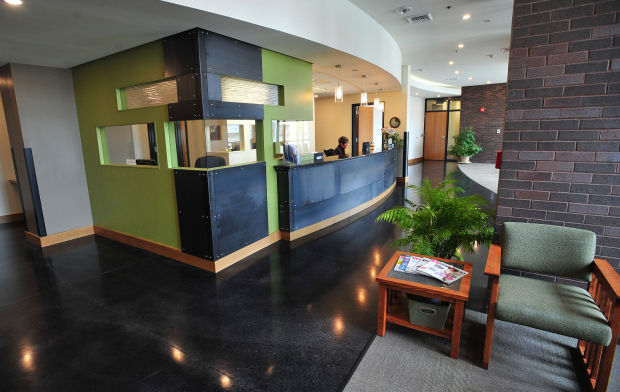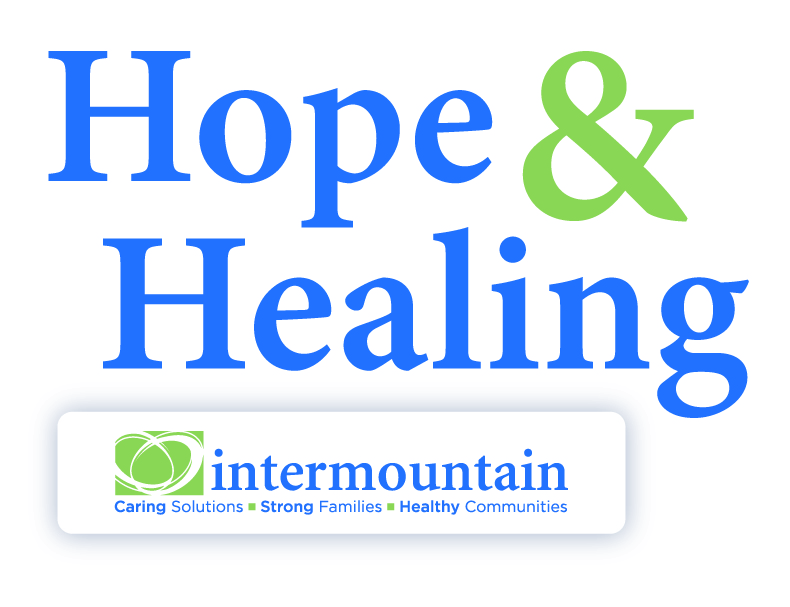
Eliza Wiley Independent Record – The entry of Intermountain’s new facility
is large and welcoming with plenty of room to grow.
April 20, 2013 12:00 am • By AL KNAUBER Independent Record • View the original article at Helenair.com
It’s not Intermountain’s new community services center with its brick exterior, stylish reception counter, unblemished carpet and large glass windows filled with sunlight that excites Jim FitzGerald, the organization’s CEO.
What truly excites him, he said, is the work that goes on inside the new 22,000-square-foot facility on Helena’s north side that donors are helping to support.
“This facility, for us, is a consolidation for our many outpatient services. It’s been pretty much a 10-year dream to get all of our services and staff under one roof,” FitzGerald said. “So it’s been a long time in coming.”
“The services in this building are for all kids who are struggling, who are having vulnerability issues, emotional health, well-being issues, mental health issues,” FitzGerald said. “This is not an extension of our residential program. This is a branching out, a reaching out to the entire community.”
The roughly $5.5 million building, he explained, “allows us to optimize what our donors have allowed us to put together.”
Today’s ribbon cutting ceremony at 1:30 p.m. will celebrate the new facility and open the next chapter in the organization’s 104-year history. FitzGerald credits the new building to the generosity of those who have contributed toward Intermountain’s success and said, “If it wasn’t for our donors, we could never have put it all together, to push that leading edge of what’s possible.”
Last year, Intermountain, with offices in Butte, Kalispell, Missoula and Great Falls, served 1,334 children and their families, according to the organization’s 2013 annual report.
A dozen years ago, FitzGerald said, Intermountain served 50 children a day. Today, it’s providing care for more than 700 children a day. Of that total, about 550 children — they typically fall between the ages of 4 and into their 20s — are enrolled in services here in Helena.
Intermountain has gone from what FitzGerald calls a small in-patient provider to one that now helps to provide early intervention for children on a trajectory that would lead to more restrictive care.
It still offers residential, therapeutic care but for only 32 children at a location across town where two of its four cottages are being converted to another use and two new ones are under construction.
“One of the things it’s really important for the community to understand is that mental illness and having mental health issues is not something that is for someone else. So many of our friends, neighbors and relatives we all know suffer from time to time with depression, anxiety and other issues from mental health,” said Susan Dreyfus, president and CEO of Families International and the Alliance for Children and Families, who was the keynote speaker for a Friday night event at Intermountain. She has been in Helena this week to meet with Intermountain’s board and staff.
Dreyfus said she sees Intermountain as “a proud beacon of light in the community.”
Intermountain is in the forefront of a national movement in providing mental health services to children and young adults that seeks to keep them in their homes as opposed to relying on residential settings, Dreyfus said.
It’s also employing the latest in childhood research to help guide its efforts.
“Intermountain was one of the first in this country to really embrace the adverse childhood experiences science,” Dreyfus said, noting that one of its leading researchers is Dr. Robert Anda, who is on the ChildWise Institute board of directors, which is affiliated with Intermountain. ChildWise seeks to advance awareness, knowledge and advocate for change to optimize society’s resources for the well-being of children.
Adverse childhood experiences can be a variety of events, but according to Dreyfus and FitzGerald they take a significant toll on children. They can be traced to health and psychological problems as children grow into adulthood too.
“There’s research that shows that these adverse childhood experiences, as they accumulate, they really become a great predictor for illness and disease in later life — for inability to attach to the work force, inability to secure meaningful and productive relationships. But the other thing we know about adverse childhood experiences is that they are compounded by poverty,” Dreyfus said.
When these adverse childhood experiences exceed a child’s ability to cope with them, which is how FitzGerald and Dreyfus describe trauma in children’s daily lives, the effects are serious and long-lasting.
Uncertainty of where a child’s next meal will come from, whether the family’s housing is secure and continually shifting from one school to another are all examples of what Dreyfus said can become toxic stress that produces trauma in children.
“The study (on adverse childhood experiences) clearly indicates that childhood trauma has a high correlation, has a high predictive value for negative outcomes for your entire life span,” FitzGerald said.
Trauma from childhood remains with us and shapes us throughout our lives, he noted, adding “That trauma lives with us until the day that we die.”
Mental health services for children nationally have not received the attention that they deserve, Dreyfus said.
“Only 10 percent of your health is predicated on what you get at your doctor’s office,” Dreyfus said. “The rest is your emotional well-being. It’s your emotional well-being and your social supports.”
Some of the recent national tragedies have brought new awareness to the lack of attention given to mental health care for children, she said, explaining that this includes those who aren’t diagnosed but are experiencing behavioral changes and issues that impair their abilities to be successful in school or within their families.
Addressing children’s mental well-being, she added, can help them navigate daily challenges in their lives.
“It’s a broader equation than just treating mental illness in kids,” Dreyfus said.
“We have a significant and growing number of young people who in regards to their emotional health and well being are highly marginalized and at risk,” Fitzgerald said.
“And they end up struggling mightily,” Dreyfus added. “You end up finding them in our child welfare systems, and in our juvenile justice systems. You’ll find them unable to successfully get through school.”
America is not a child-centered culture, FitzGerald said. “We may indulge our children, but we don’t meet their needs increasingly.”
Far poorer regions of the world have much more intact and high-functioning families in which children are nurtured and cared for better than in this country, he added.
Expecting children to simply grow out of difficult times in their lives may no longer be the best solution to helping them with these difficulties, in FitzGerald’s view.
The fast-paced world of today pushes out the connectedness and well-being of people and families, he noted, adding “All in all, we have a young population that’s not faring well across the country.”




